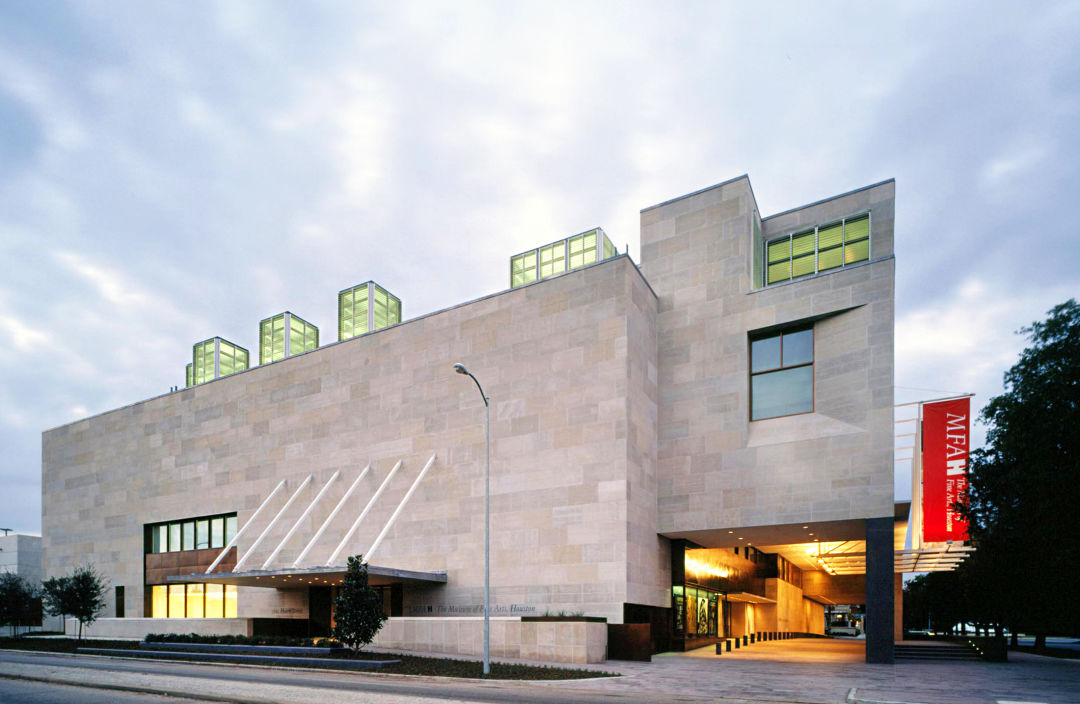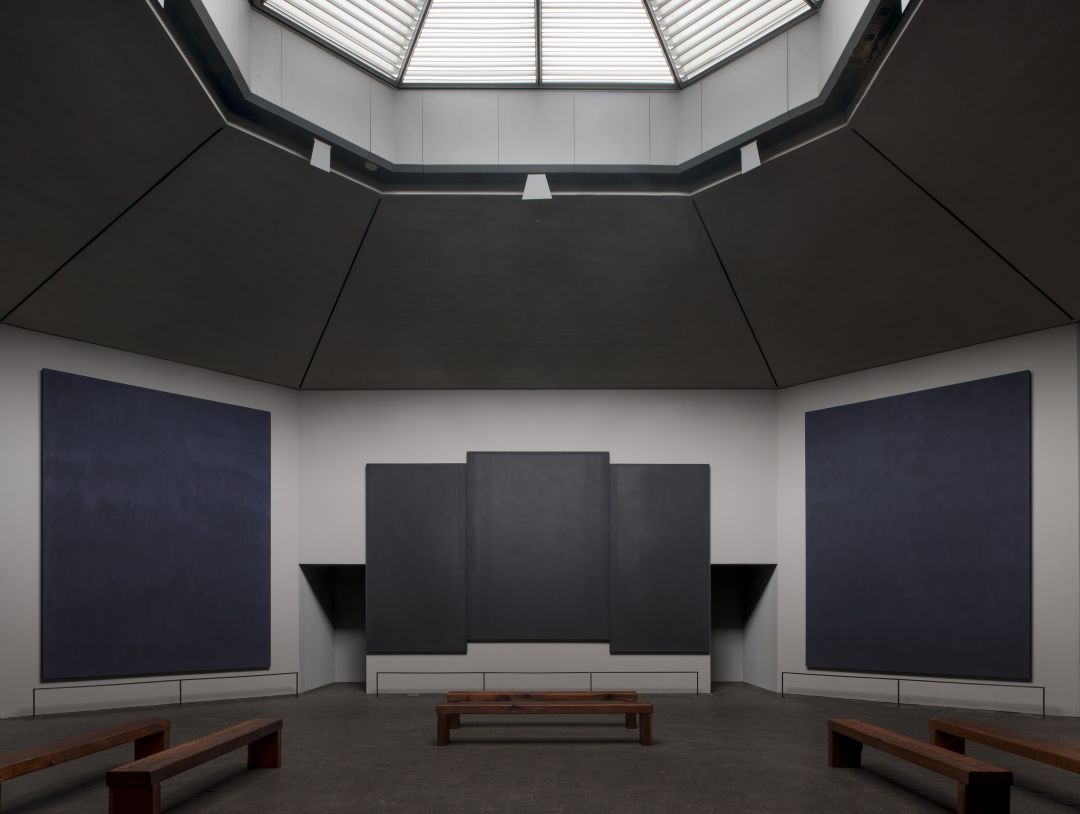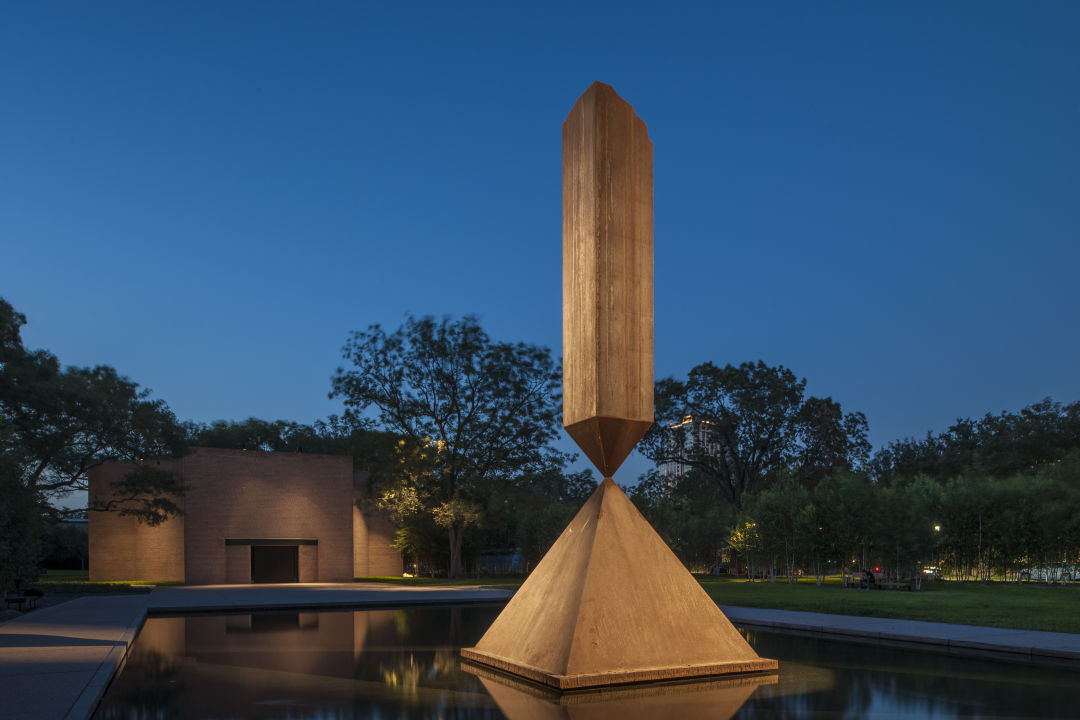Art Preservation in the Era of Climate Change: Local Museums Speak Out

2024 was not a great year for Houston weather. In May, a derecho—not an especially common occurrence in the Gulf Coast—raged for two days, causing somewhere between $5 and $8 billion in damages. Two months later, amid recovery and cleanup efforts, Hurricane Beryl struck on July 8, leaving behind another wake of destruction totaling billions of dollars.
Rothko Chapel was among Beryl’s most high-profile victims, and closed to the public from July to December 2024 for repairs. The building and four out of 14 of its Mark Rothko paintings suffered major water damage when a brick in the wall sprang a leak, leading to a clogged drain that subsequently overflowed inside. It was possible to clean up and rehang only one of the paintings at the chapel itself. The east wall triptych remains off-site while it continues undergoing repairs.
Well-wishers across the globe contributed donations ranging from $5 to $10,000, and the Ford Foundation, Mellon Foundation, and Henry Luce Foundation all contributed money toward grants that would help reopen the interfaith chapel. It was a heartwarming lesson in how the arts resonate across borders, as well as a heartbreaking harbinger of the challenges organizations face in the era of climate change.

“Owning buildings in climate-challenging environments like Houston sets up a whole set of problems, things that are going to be unknown until they’re known,” says David Leslie, the now-retired executive director of Rothko Chapel who oversaw the restorations.
Despite undergoing “a robust maintenance program” and a full renovation beginning in 2019, the spot where the leak sprang up in the museum went undetected during routine checks; it was simply too small to detect with either the naked eye or the available equipment. “You can do all the best planning. You can [have] good maintenance programs, and yet there’s still…a heightened level of susceptibility,” Leslie says. “Even with all of that…we’re still faced with an unknown. So, I would just say that is the new now, right? That is the new normal.”
The chapel’s 2019 renovation involved reinforcing the walls with steel rebar to better withstand extreme storms, but it only held up so much to the surprise one-two punch of the derecho and Beryl’s catastrophic winds. As a direct response to these incidents, the Rothko Chapel leadership began investing more in prophylactic measures, including floodgates, sandbags, and intensive stress tests to assess the building’s structural readiness for future storms. Leslie notes that water stress tests aren’t always feasible, as they risk causing the very hazards they hope to prevent.
Before retiring, he helped oversee comprehensive research into the relationship between art preservation and climate change, using Rothko Chapel as the center point. The final report is still underway, but Leslie says a key to preserving and keeping collections safe, particularly for organizations in hurricane-prone areas, is the development of tight-knit relationships between museums and galleries.
Rothko Chapel’s tiny team “is kind of in a unique spot” without on-site art handlers, which “adds another level of vulnerability,” he says. But the space’s close ties with the Museum of Fine Arts, Houston (MFAH), the Menil Collection, and professional art handlers proved critical in a crisis. After Beryl, these connections provided swift support to Rothko Chapel, linking them with the resources necessary to make immediate repairs, rescuing priceless works of art before the damage became permanent. It’s a model Leslie recommends to other small arts organizations, if they haven’t done so already.
MFAH also concerns itself with how Houston’s erratic climate may cause physical harm to its holdings. While the museum survived Beryl unscathed, it wasn’t as fortunate during Harvey. Both the Rienzi house museum and its Bayou Bend Collection and Gardens satellite campus, located along Kirby Drive, were affected by the hurricane, experiencing critical structural damage, including flooded basements and complete building submersion. In response, the museum has since added waterproof doors to the Rienzi house. It is also involved with multiple organizations concerned with disaster mitigation in the arts, and, like its peers at Rothko Chapel, are upgrading its structures to help barricade against flooding.
“Every year before the hurricane season, we meet and we discuss how to best improve our practices, but also the buildings,” says Per Knutås, head of conservation at MFAH. He notes that the museum is planning an updated water blockage system for its garage connecting the Kinder Building to the Glassell School of Art. “We’re one of the few places in Houston with a basement and underground parking, and obviously we want to prevent any flash flooding…so we’re investing quite a good amount of money to prepare for hurricanes and for water.”
Adapting to new climate realities also involves upgrading in-studio practices. MFAH’s preservation personnel are wrapping up three years of European Union–funded research aimed at identifying the best and safest restoration practices. “What we use when we remove unwanted materials from surfaces or from materials is usually very harsh, toxic solvents, and we’re finding ways of replacing those solvents with greener alternatives, not adding on to the waste and the way of climate change,” Knutås says.
The University of Florence invited Knutås, his MFAH preservation team, and 28 other organizations to develop new art preservation standards that won’t contribute to ecological devastation. One example currently employed at the museum involves a proprietary microemulsion cleaning gel—a safer, healthier alternative for both conservators and the environment.
MFAH, which is also a member of the American Institute for Conservation, hosts multiple workshops for its industry peers on how to incorporate this technology into their processes. It remains in constant dialogue with other arts organizations in coastal areas who share many of the same concerns as their Houstonian counterparts.

“There’s obviously a huge, growing interest in sustainability within museums, from the practical standpoint of how museums transition to net zero,” says Aaron Ambroso, codirector of the Houston Climate Justice Museum.
This by-appointment-only institution, which examines the impact of climate change on vulnerable, under-resourced communities of color through visual art and performance, solves the issue of protecting its art in a thematically appropriate way: It doesn’t have a permanent collection.
Some of this was a practical decision made at the museum’s inception; all artists featured in exhibits are notified that their pieces will not be held following the show’s conclusion. Not needing to store works helps keep costs low, especially during a time when the National Endowment for the Arts and other grant providers are slashing funding. This also aligns with the museum’s overarching commitment to minimizing its own environmental impact. “The issue with preservation is that all of those systems that are required for preservation—temperature control, humidity, all those things—are both expensive and…are usually powered by fossil fuels,” Ambroso says.
Extreme weather events like Beryl and the preceding derecho will, unfortunately, continue to be a reality for Houston and its visual art scene until legislatures and corporations recognize the existential threat of climate change. Sustainable practices, along with more comprehensive routine inspections and repairs, are vital. Museums and galleries with permanent collections can no longer afford to wait or trust that established weather patterns will remain reliable.
“Maybe people thought that [trainings or experts or consultants] could have been a luxury item at some point, because a lot of times you have to pay for it,” Leslie says. “But I would say [to] make that an essential part of your budget…because the risk is too high.”




